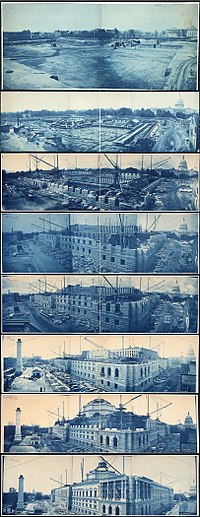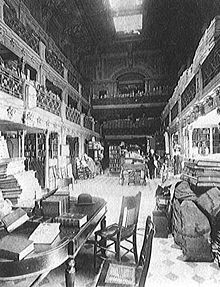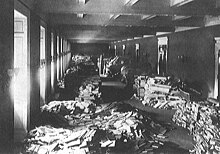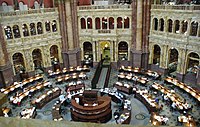| Library of Congress | |
|---|---|
  | |
| Location | Washington, D.C. |
| Established | 1800 |
| Branches | n/a |
| Collection | |
| Size | 30,011,749 Books (134,517,714 total Items) [1] |
| Access and use | |
| Circulation | library does not publicly circulate |
| Population served | 535 members of the United States Congress, their staff, and members of the public |
| Other information | |
| Budget | $603,623,000 [2] |
| Director | James H. Billington (Librarian of Congress) |
| Employees | 3,783 [3] |
| Website | http://www.loc.gov |

The Library of Congress is the de facto national library of the United States and the research arm of the United States Congress. Located in Washington, D.C., it is the largest by shelf space and one of the most important libraries in the world. Its collections include more than 30 million catalogued books and other print materials in 470 languages; more than 58 million manuscripts; the largest rare book collection in North America, including a Gutenberg Bible (one of only four perfect vellum copies known to exist); over 1 million US Government publications; 1 million issues of world newspapers spanning the past three centuries; 33,000 bound newspaper volumes; 500,000 microfilm reels; over 6,000 comic books [4] titles; the world's largest collection of legal materials; films; 4.8 million maps; sheet music; 2.7 million sound recordings; the Betts Stradivarius; and the Cassavetti Stradivarius. The head of the Library is the Librarian of Congress.
History
Origins and Jefferson's donation (1800-1851)
The Library of Congress was established on April 24, 1800, when President John Adams signed an act of Congress providing for the transfer of the seat of government from Philadelphia to the new capital city of Washington. Part of the legislation appropriated $5,000 "for the purchase of such books as may be necessary for the use of Congress ..., and for fitting up a suitable apartment for containing them...." Books were ordered from London and the collection, consisting of 740 books and three maps, was housed in the new Capitol. [5]
Thomas Jefferson played an important role in the Library's early formation, signing into law on January 26, 1802 the first law establishing the structure of the Library of Congress. The law established the presidentially-appointed post of Librarian of Congress and a Joint Committee on the Library to regulate and oversee the Library, as well as giving the President and Vice President the ability to borrow books. [5] The Library of Congress was destroyed in August 1814, when invading British troops set fire to the Capitol building and the small library of 3,000 volumes within. [5]
Within a month, the now former President Jefferson offered his personal library as a replacement. Jefferson had spent 50 years accumulating a wide variety of books, including ones in foreign languages and volumes of philosophy, science, literature, and other topics not normally viewed as part of a legislative library, such as cookbooks, writing that, "I do not know that it contains any branch of science which Congress would wish to exclude from their collection; there is, in fact, no subject to which a Member of Congress may not have occasion to refer." In January 1815, Congress accepted Jefferson's offer, appropriating $23,950 for his 6,487 books. [5]
Weakening (1851-1865)
The antebellum period was difficult for the Library. During the 1850s the Smithsonian Institution's librarian Charles Coffin Jewett aggressively tried to move that organization towards becoming the United States' national library. His efforts were blocked by the Smithsonian's Secretary Joseph Henry, who advocated a focus on scientific research and publication and favored the Library of Congress' development into the national library. Henry's dismissal of Jewett in July 1854 ended the Smithsonian's attempts to become the national library, and in 1866 Henry transferred the Smithsonian's forty thousand-volume library to the Library of Congress. [5]
On December 24, 1851 the largest fire in the Library's history destroyed 35,000 books, about two-thirds of the Library's 55,000 book collection, including two-thirds of Jefferson's original donation. [5] Congress quickly appropriated in 1852 $168,700 to replace the lost books but not for the acquisition of new materials. This marked the start of a conservative period in the Library's administration under Librarian John Silva Meehan and Joint Committee Chairman James A. Pearce, who worked to restrict the Library's activities. [5] In 1857, Congress transferred the Library's public document distribution activities to the Department of the Interior and its international book exchange program to the Department of State. The centralization of copyright offices into the United States Patent Office in 1859 ended the Library's thirteen year role as a depository of all copyrighted books and pamphlets. Abraham Lincoln's political appointment of John G. Stephenson as Librarian of Congress in 1861 further weakened the Library; Stephenson's focus was on non-Library affairs, including service as a volunteer aide-de-camp at the battles of Chancellorsville and Gettysburg during the American Civil War. By the conclusion of the war, the Library of Congress had a staff of seven for a collection of eighty thousand volumes. [5]
Spofford's expansion (1865-1897)

The Library of Congress reasserted itself during the latter half of the 19th century under Librarian Ainsworth Rand Spofford, who directed the Library from 1865 to 1897. Aided by an overall expansion of the federal government and a favorable political climate, Spofford built broad bipartisan support for the Library as a national library and a legislative resource, began comprehensively collecting Americana and American literature, and led the construction of a new building to house the Library, and transformed the Librarian of Congress position into one of strength and independence. [5] Between 1865 and 1870, Congress appropriated funds for the construction of the Thomas Jefferson Building, placed all copyright registration and deposit activities under the Library's control, and restored the Library's international book exchange. The Library also acquired the vast libraries of both the Smithsonian and historian Peter Force, strengthening its scientific and Americana collections significantly. By 1876, the Library of Congress had 300,000 volumes and was tied with Boston Public Library as the nation's largest library. When the Library moved from the Capitol Building to its new headquarters in 1897, it had over 840,000 volumes, 40% of which had been acquired through copyright deposit. [5]

A year before the Library's move to its new location, the Joint Library Committee held a session of hearings to assess the condition of the Library and plan for its future growth and possible reorganization. Spofford and six experts sent by the American Library Association, including future Librarian of Congress Herbert Putnam and Melvil Dewey of the New York State Library, testified before the committee that the Library should continue its expansion towards becoming a true national library. [5] Based on the hearings and with the assistance of Senators Justin Morrill of Vermont and Daniel Voorhees of Indiana, Congress more than doubled the Library's staff from 42 to 108 and established new administrative units for all aspects of the Library's collection. Congress also strengthened the office of Librarian of Congress to govern the Library and make staff appointments, as well as requiring Senate approval for presidential appointees to the position. [5]
Post-reorganization (1897-1939)

The Library of Congress, spurred by the 1897 reorganization, began to grow and develop more rapidly. Spofford's successor John Russell Young, though only in office for two years, overhauled the Library's bureaucracy, used his connections as a former diplomat to acquire more materials from around the world, and established the Library's first assistance programs for the blind and physically disabled. [5] Young's successor Herbert Putnam held the office for forty years from 1899 to 1939, entering into the position two years before the Library became the first in the United States to hold one million volumes. [5] Putnam focused his efforts on making the Library more accessible and useful for the public and for other libraries. He instituted the interlibrary loan service, tranforming the Library of Congress into what he referred to as a "library of last resort". [6] Putnam also expanded Library access to "scientific investigators and duly qualified individuals" and began publishing primary sources for the benefit of scholars. [5]
Putnam's tenure also saw increasing diversity in the Library's acquisitions. In 1903 he persuaded President Theodore Roosevelt to transfer by executive order the papers of the Founding Fathers from the State Department to the Library of Congress. Putnam expanded foreign acquisitions as well, including the 1904 purchase of a four-thousand volume library of Indica, the 1906 purchase of G. V. Yudin's eighty-thousand volume Russian library, the 1908 Schatz collection of early opera librettos, and the early 1930s purchase of the Russian Imperial Collection, consisting of 2,600 volumes from the library of the Romanov family on a variety of topics. Collections of Hebraica and Chinese and Japanese works were also acquired. [5] Congress even took the initiative to acquire materials for the Library in one occasion, when in 1929 Congressman Ross Collins of Mississippi successfully proposed the $1.5 million purchase of Otto Vollbehr's collection of incunabula, including one of three remaining perfect vellum copies of the Gutenberg Bible. [5]
In 1914 Putnam established the Legislative Reference Service as a separative administrative unit of the Library. Based in the Progressive era's philosophy of science as a problem-solver, and modeled after successful research branches of state legislatures, the LRS would provide informed answers to Congressional research inquiries on almost any topic. [5] In 1925 Congress passed an act allowing the Library of Congress to establish a Trust Fund Board to accept donations and endowments, giving the Library a role as a patron of the arts. The Library received the donations and endowments of prominent individuals such as John D. Rockefeller, James B. Wilbur and Archer M. Huntington. Gertrude Clarke Whittall donated five Stradivarius violins to the Library and Elizabeth Sprague Coolidge's donations paid for a concert hall within the Library of Congress building and the establishment of an honorarium for the Music Division. A number of chairs and consultantships were established from the donations, the most well-known of which is the Poet Laureate Consultant. [5]
The Library's expansion eventually filled the Library's Main Building despite shelving expansions in 1910 and 1927, forcing the Library to expand into a new structure. Congress acquired nearby land in 1928 and approved construction of the Annex Building (later the John Adams Building) in 1930. Although delayed during the Depression years, it was completed in 1938 and opened to the public in 1939. [5]
Modern history (1939-present)
When Putnam retired in 1939, President Franklin D. Roosevelt appointed Archibald MacLeish as his successor. Occupying the post from 1939 to 1944 during the height of World War II, MacLeish became the most visible Librarian of Congress in the Library's history. MacLeish encouraged librarians to oppose totalitarianism on behalf of democracy; dedicated the South Reading Room of the Adams Building to Thomas Jefferson, commissioning artist Ezra Winter to paint four themed murals for the room; and established a "democracy alcove" in the Main Reading Room of the Jefferson Building for important documents such as the Declaration, Constitution and Federalist Papers. [5] Even the Library of Congress assisted during the war effort, ranging from the storage of the Declaration of Independence and the United States Constitution in Fort Knox for safekeeping to researching weather data on the Himalayas for Air Force pilots. [5] MacLeish resigned in 1944 to become Assistant Secretary of State, and President Harry Truman appointed Luther H. Evans as Librarian of Congress. Evans, who served until 1953, expanded the Library's acquisitions, cataloging and bibliographic services as much as the fiscal-minded Congress would allow, but his primary achievement was the creation of Library of Congress Missions around the world. Missions played a variety of roles in the postwar world: the mission in San Francisco assisted participants in the meeting that established the United Nations, the mission in Europe acquired European publications for the Library of Congress and other American libraries, and the mission in Japan aided in the creation of the National Diet Library. [5]
Evans' successor L. Quincy Mumford took over in 1953. Mumford's tenure, lasting until 1974, saw the initiation of the construction of the Monroe Building, the third Library of Congress building. Mumford directed the Library during a period of increased educational spending, the windfall of which allowed the Library to devote energies towards establishing new acquisition centers abroad, including in Cairo and New Delhi. In 1967 the Library began experimenting with book preservation techniques through a Preservation Office, which grew to become the largest library research and conservation effort in the United States. [5] Mumford's administration also saw the last major public debate about the Library of Congress' role as both a legislative library and a national library. A 1962 memorandum by Douglas Bryant of the Harvard University Library, compiled at the request of Joint Library Committee chairman Claiborne Pell, proposed a number of institutional reforms, including expansion of national activities and services and various organizational changes, all of which to shift the Library more towards its national role over its legislative role. Bryant even suggested possibly changing the name of the Library of Congress, which was rebuked by Mumford as "unspeakable violence to tradition". [5] Debate continued within the library community until the Legislative Reorganization Act of 1970 shifted the Library back towards its legislative roles, placing greater focus on research for Congress and congressional committees and renaming the Legislative Reference Service to the Congressional Research Service. [5]
After Mumford retired in 1974, Gerald Ford appointed Daniel J. Boorstin as Librarian. Boorstin's first challenge was the move to the new Monroe Building, which took place between 1980 and 1982. The move released pressures on staff and shelf space, allowing Boorstin to focus on other areas of Library administration such as acquisitions and collections. Taking advantage of steady budgetary growth, from $116 million in 1975 to over $250 million by 1987, Boorstin actively participated in enhancing ties with scholars, authors, publishers, cultural leaders, and the business community. His active and prolific role changed the post of Librarian of Congress so that by the time he retired in 1987, the New York Times called it "perhaps the leading intellectual public position in the nation." [5] Ronald Reagan appointed James H. Billington as the thirteenth Librarian of Congress in 1987, a post he holds as of 2008. Billington took advantage of new technological advancements and the Internet to link the Library to educational institutions around the country in 1991. The end of the Cold War also enabled the Library to develop relationships with newly open Eastern European nations, helping them to establish parliamentary libraries of their own. [5]
Buildings of the Library
The Library of Congress is physically housed in three buildings in Washington, D.C..
Thomas Jefferson Building
The Thomas Jefferson Building is located between Independence Avenue and East Capitol Street on First Street SE. Originally known simply as the Library of Congress Building, it was the first building set aside for the Library of Congress after residing in the U.S. Capitol Building since its inception. First proposed by Librarian Ainsworth Rand Spofford in 1871, it was authorized by Congress in 1886. The design, chosen after much debate, was in the Italian Renaissance style. [5]
John Adams Building
The John Adams Building is located between Independence Avenue and East Capitol Street on 2nd Street SE. It opened in 1938 as an annex to the main building.
James Madison Memorial Building
The James Madison Memorial Building is located between First and Second Streets on Independence Avenue SE. It opened in 1981 as the new headquarters of the Library. The James Madison Memorial Building also serves as the official memorial to James Madison.
(Note: Between April 13, 1976 and June 13, 1980, the John Adams Building was known as the Thomas Jefferson Building.)
In late-November 2005, the Library announced intentions to launch the World Digital Library, digitally preserving books and other objects from all world cultures.
Holdings

The Library developed a system of book classification called Library of Congress Classification (LCC) which is used by most US research and university libraries, although most public libraries continue to use the Dewey decimal system.
The Library serves as a legal repository for copyright protection and copyright registration, and as the base for the United States Copyright Office. Regardless of whether they are seeking copyright, all publishers are required to submit two copies of their copyrightable works to the Library - this requirement is known as mandatory deposit. [7] Parties wishing not to publish, need only submit one copy of their work. Nearly 22,000 new items published in the U.S. arrive every business day at the Library. Contrary to popular belief, however, the Library does not retain all of these works in its permanent collection, although it does add an average of 10,000 items per day. Rejected items are used in trades with other libraries around the world, distributed to federal agencies, or donated to schools, communities, and other organizations within the United States. [8] As is true of many similar libraries, the Library of Congress retains copies of every publication in the English language which is deemed significant.
The Guinness Book of World Records currently lists the Library of Congress as the "World's Largest Library". [9] This apparently is based on the shelf space the collection occupies; the Library of Congress states that its collection fills about 530 miles (850 km), [10] while the British Library, reports about 388 miles (625 km) of shelves. [11] The Library of Congress holds about 130 million items with 29 million books against approximately 150 million items with 25 million books for the British Library. [10] [11]
It is estimated that the print holdings of the Library of Congress would, if digitized and stored as plain text, constitute 17 to 20 terabytes of information. This leads many people to conclude that 20 terabytes is equivalent to the entire holdings of the Library, but this is misleading because the Library contains many items in addition to books, such as photographs, maps, and sound recordings. (Occasionally, this figure has been referred to as a data transfer rate, LoC/s — Libraries of Congress per second – defined as 20 terabytes of data transferred per second). The Library currently has no plans for systematic digitization of any significant portion of its books.
The Library makes millions of digital objects, comprising tens of terabytes, available at its American Memory site. American Memory is a source for public domain image resources, as well as audio, video, and archived Web content. Nearly all of the lists of holdings, the catalogs of the library, can be consulted directly on its web site. Librarians all over the world consult these catalogs, through the Web or through other media better suited to their needs, when they need to catalog for their collection a book published in the United States. They use the Library of Congress Control Number to make sure of the exact identity of the book.
The Library of Congress also provides an on-line archive of the proceedings of the U.S. Congress at THOMAS, including bill text, Congressional Record text, bill summary and status, the Congressional Record Index, and the United States Constitution.
The Library also administers the National Library Service for the Blind and Physically Handicapped, a talking and Braille library program provided to more than 766,000 Americans.
Collections
Books
Manuscripts
Newspapers
Maps
Film
Music
Using the Library

The library is open to the general public for academic research, and runs tours for visitors. Only those who are issued a "Reader Identification Card" may enter the reading rooms and access the collection. The Reader Identification Card is available in the Madison building to persons who are at least 18 years of age upon presentation of a government issued picture identification (e.g., driver's license, state ID card or passport). However, only members of Congress, Supreme Court Justices, their staff, Library of Congress staff and certain other government officials can actually check out books. During the 110th Congress, in the Fall, United States House of Representatives Pages were given Library of Congress Reader Cards for the first time in the Page Program's history, giving them access to the large reading rooms available in the Library of Congress. Pages can be as young as 16 years of age.
Since 1902, libraries in the United States have been able to request books and other items through interlibrary loan from the Library of Congress if these items are not readily available elsewhere. Through this, the Library of Congress has served as a "library of last resort", according to former Librarian of Congress Herbert Putnam. [6]
Annual events

- The National Book Festival
- Founder's Day Celebration
- Gershwin Prize for Popular Song
- Archives Fair
- Judith P. Austin Memorial Lecture
- Davidson Fellows Reception
See also
- Congressional Research Service
- Library of Congress Classification
- Library of Congress Country Studies
- Library of Congress Living Legend
- Library of Congress Subject Headings
- National Film Registry
- National Recording Registry
- Poet Laureate Consultant in Poetry to the Library of Congress
- United States Copyright Office
- United States Senate Library
- Documents Expediting Project
- The Feleky Collection
- World Digital Library
- Library of Parliament (Canada)
- House of Commons Library, Parliamentary Archives, British Library (UK)
References
- ^ Annual report 2006
- ^ Annual report 2006
- ^ Year 2006 at a glance
-
^
"About the Serial and Government Publications Division". The Library of Congress.
2006-04-07. Retrieved 2006-08-08.
{{ cite web}}: Check date values in:|date=( help) - ^
a
b
c
d
e
f
g
h
i
j
k
l
m
n
o
p
q
r
s
t
u
v
w
x
y
z
aa
ab
ac
"Jefferson's Legacy: A Brief History of the Library of Congress".
Library of Congress.
2006-03-06. Retrieved 2008-01-14.
{{ cite web}}: Check date values in:|date=( help) Cite error: The named reference "loc history" was defined multiple times with different content (see the help page). - ^
a
b
"Interlibrary Loan (Collections Access, Management and Loan Division, Library of Congress".
Library of Congress website.
2007-10-25. Retrieved 2007-12-04.
{{ cite web}}: Check date values in:|date=( help) -
^
"Mandatory Deposit". Copyright.gov. Retrieved 2006-08-08.
{{ cite web}}: Cite has empty unknown parameter:|coauthors=( help) -
^
"Fascinating Facts". Library of Congress. Retrieved 2006-08-08.
{{ cite web}}: Cite has empty unknown parameter:|coauthors=( help) -
^
"Largest Library". Guinness Book of World Records. Retrieved 2006-08-08.
{{ cite web}}: Cite has empty unknown parameter:|coauthors=( help) - ^
a
b
"About the Library". Library of Congress. Retrieved 2006-08-08.
{{ cite web}}: Cite has empty unknown parameter:|coauthors=( help) - ^
a
b
"Did You Know?". British Library. Retrieved 2006-08-08.
{{ cite web}}: Cite has empty unknown parameter:|coauthors=( help)
External links
-
The Library of Congress website
- History of the Library of Congress
- American Memory
- Search the Library of Congress catalog
- thomas.loc.gov, legislative information
- Works by the Library of Congress at Project Gutenberg
- Standards, The Library of Congress
- Library Of Congress Meeting Notices and Rule Changes from The Federal Register RSS Feed
- Outdoor sculpture at the Library of Congress
38°53′20″N 77°00′16″W / 38.888841°N 77.004531°W
[[Category:Library of Congress| ]] [[Category:Archives in the United States]] [[Category:Agencies of the United States Congress]] [[Category:Landmarks in Washington, D.C.]] [[Category:Libraries in Washington, D.C.|Congress, Library of]] [[Category:National Historic Landmarks in Washington, D.C.]] [[Category:National libraries|Congress, Library of]] [[Category:1800 establishments]] [[Category:Film archives]] [[Category:Registered Historic Places in the District of Columbia]] [[Category:Research libraries]] [[ar:مكتبة الكونغرس]] [[de:Library of Congress]] [[es:Biblioteca del Congreso de Estados Unidos]] [[eo:Biblioteko de Kongreso]] [[fa:کتابخانه ملی کنگره آمریکا]] [[fr:Bibliothèque du Congrès]] [[it:Library of Congress]] [[he:ספריית הקונגרס]] [[lb:Library of Congress]] [[nl:Library of Congress]] [[ja:アメリカ議会図書館]] [[no:Library of Congress]] [[pl:Biblioteka Kongresu Stanów Zjednoczonych]] [[pt:Biblioteca do Congresso]] [[ru:Библиотека Конгресса]] [[sr:Конгресна библиотека]] [[sv:Library of Congress]] [[tr:Amerika Birleşik Devletleri Kongre Kütüphanesi]] [[zh:國會圖書館 (美國)]]
